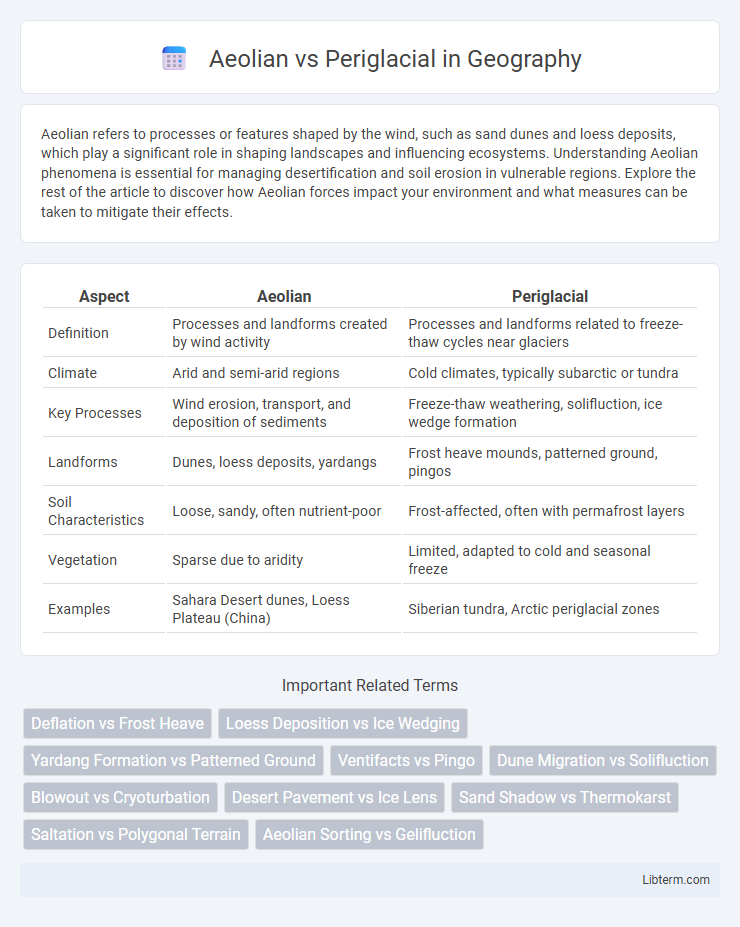Aeolian refers to processes or features shaped by the wind, such as sand dunes and loess deposits, which play a significant role in shaping landscapes and influencing ecosystems. Understanding Aeolian phenomena is essential for managing desertification and soil erosion in vulnerable regions. Explore the rest of the article to discover how Aeolian forces impact your environment and what measures can be taken to mitigate their effects.
Table of Comparison
| Aspect | Aeolian | Periglacial |
|---|---|---|
| Definition | Processes and landforms created by wind activity | Processes and landforms related to freeze-thaw cycles near glaciers |
| Climate | Arid and semi-arid regions | Cold climates, typically subarctic or tundra |
| Key Processes | Wind erosion, transport, and deposition of sediments | Freeze-thaw weathering, solifluction, ice wedge formation |
| Landforms | Dunes, loess deposits, yardangs | Frost heave mounds, patterned ground, pingos |
| Soil Characteristics | Loose, sandy, often nutrient-poor | Frost-affected, often with permafrost layers |
| Vegetation | Sparse due to aridity | Limited, adapted to cold and seasonal freeze |
| Examples | Sahara Desert dunes, Loess Plateau (China) | Siberian tundra, Arctic periglacial zones |
Introduction to Aeolian and Periglacial Processes
Aeolian processes involve the transportation and deposition of sediments by wind, primarily shaping desert landscapes and coastal dunes through erosion, saltation, and deflation. Periglacial processes occur in cold, non-glacial environments where freeze-thaw cycles dominate, resulting in soil frost action, patterned ground formation, and solifluction. Both processes critically influence landform development but operate under distinct climatic and environmental conditions.
Defining Aeolian Environments
Aeolian environments are characterized by the action of wind as the primary agent of sediment transport and deposition, shaping landscapes through processes like erosion, deflation, and dune formation. These environments typically occur in arid and semi-arid regions where loose, dry sediments such as sand and silt are abundant and vegetation cover is sparse, allowing wind to mobilize particles effectively. Unlike periglacial environments dominated by freeze-thaw cycles and frost action, aeolian systems are defined by the kinetic energy of wind influencing sediment dynamics and landform development.
Understanding Periglacial Environments
Periglacial environments are characterized by cold climate conditions where freeze-thaw processes dominate, leading to unique landforms such as patterned ground, ice wedges, and solifluction lobes. Unlike aeolian environments driven primarily by wind erosion and deposition, periglacial landscapes are shaped by permafrost, seasonal frost action, and ground ice dynamics. Understanding periglacial processes provides insights into soil movement, landscape stability, and climate change impacts in Arctic and sub-Arctic regions.
Key Differences Between Aeolian and Periglacial Dynamics
Aeolian dynamics involve wind-driven processes such as erosion, transportation, and deposition of fine particles in arid and semi-arid environments, while periglacial dynamics are dominated by freeze-thaw cycles, ground ice movement, and frost action primarily found in cold, near-glacial regions. Aeolian landscapes form dunes, loess deposits, and deflation hollows, whereas periglacial landscapes feature patterned ground, frost heave, and solifluction lobes. The key difference lies in the driving force: aeolian processes depend on wind energy and sediment availability, whereas periglacial processes rely on thermal fluctuations and the presence of permafrost or seasonally frozen ground.
Major Landforms Created by Aeolian Activity
Aeolian processes primarily create landforms such as sand dunes, loess deposits, and yardangs through wind-driven erosion and deposition. These wind-shaped features are distinct from periglacial landforms, which result from freeze-thaw cycles and include patterned ground and ice wedges. The largest aeolian formations are expansive dune fields like the Sahara's Erg Chebbi and the Namib Desert's linear dunes.
Distinct Landforms Shaped by Periglacial Processes
Periglacial processes create distinct landforms such as frost wedges, patterned ground, and solifluction lobes, formed by freeze-thaw cycles and ground ice dynamics in cold, non-glacial environments. Aeolian landforms, by contrast, result from wind-driven sediment transport, forming dunes and loess deposits rather than frost-related features. The presence of features like ice wedges and patterned ground is a key indicator differentiating periglacial landscapes from aeolian terrains.
Climatic Conditions Influencing Aeolian vs Periglacial Regions
Aeolian regions are characterized by arid to semi-arid climates with limited vegetation, where strong winds facilitate the transport and deposition of sand and dust, forming dunes and loess deposits. Periglacial regions exist in cold climates near glacial areas, experiencing freeze-thaw cycles, permafrost, and seasonal temperature fluctuations that influence soil processes and geomorphology. The key climatic difference lies in the predominance of dry, warm conditions in aeolian environments versus cold, often moist conditions with thermal stress in periglacial zones.
Ecological Impacts of Aeolian and Periglacial Processes
Aeolian processes, driven by wind erosion and sediment transport, significantly shape arid and semi-arid ecosystems by influencing soil fertility, vegetation patterns, and habitat stability. Periglacial processes, characterized by freeze-thaw cycles and frost heave, impact soil structure, water availability, and vegetation dynamics in cold-climate ecosystems, often leading to patterned ground and soil displacement. Both aeolian and periglacial processes affect nutrient cycling and biodiversity, but their ecological impacts differ due to distinct climate conditions and geomorphic mechanisms.
Human Interactions with Aeolian and Periglacial Landscapes
Human interactions with aeolian landscapes often involve agriculture and infrastructure adaptation to sandy soils and wind erosion in deserts and coastal dunes. In periglacial regions, communities contend with frost action affecting building foundations, road stability, and resource extraction due to freeze-thaw cycles and permafrost presence. Both environments necessitate specialized land management strategies to mitigate environmental challenges while supporting sustainable human activities.
Conclusion: Comparing Aeolian and Periglacial Systems
Aeolian systems are primarily shaped by wind-driven processes that transport and deposit sediments in arid and semi-arid environments, while periglacial systems are dominated by freeze-thaw cycles influencing soil and landform development in cold climates. The key distinction lies in Aeolian activity's reliance on dry, windy conditions versus periglacial dynamics driven by temperature fluctuations around freezing point. Understanding these contrasting mechanisms is essential for interpreting sedimentary records and predicting landscape responses to climatic changes.
Aeolian Infographic

 libterm.com
libterm.com